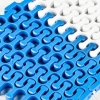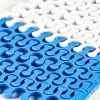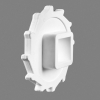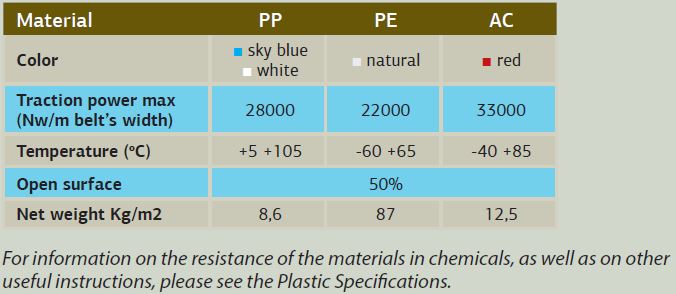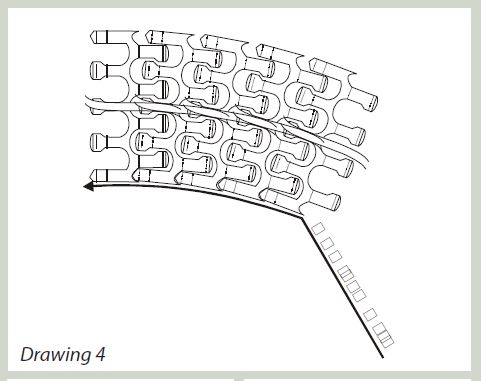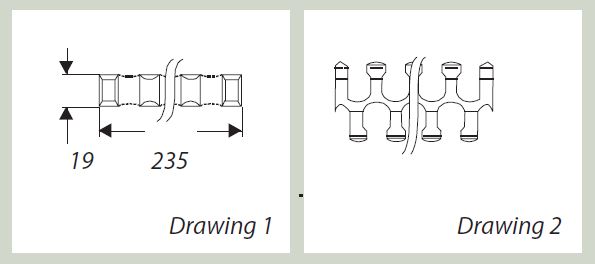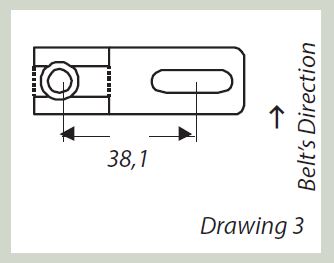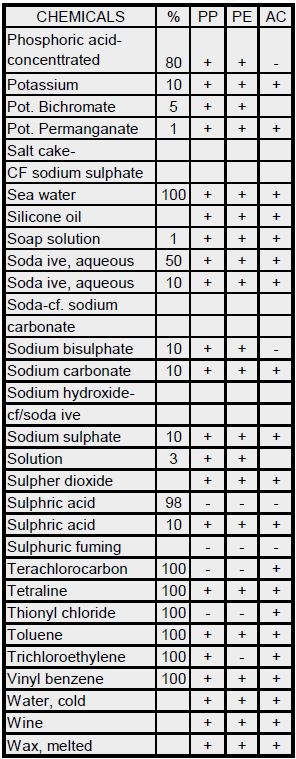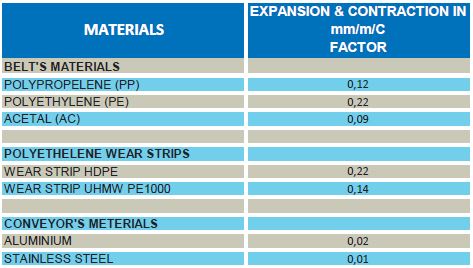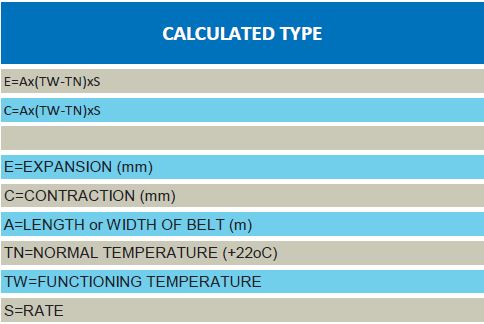S3200- Grid EN
SKU:
Type: Grid EN
Pich:38,1mm.
Segment Thickness:19mm.
Connection Rod:6,4mm.
A modular conveyor belt with radius flexibility for conveyors with one or more curves and for conveyors with a spiral shape.
The radius is 2,5 Χ belt’s width (R=width Χ 2,5).
The radius (R) defines the smallest (internal) radius of the belt (drawing 4).
Its surface is grid, flat and smooth.
The open surface of the belt is 50%, enabling the draining of water and gasses.
By assembling the segments to each other, you can create belts with a width from 80 up to 3000 mm. and unlimited length.
The motion transmission is made by the plastic sprockets ALPHAbelt S.3200. It has invariable and stable motion guided by the central sprockets on the two shafts.
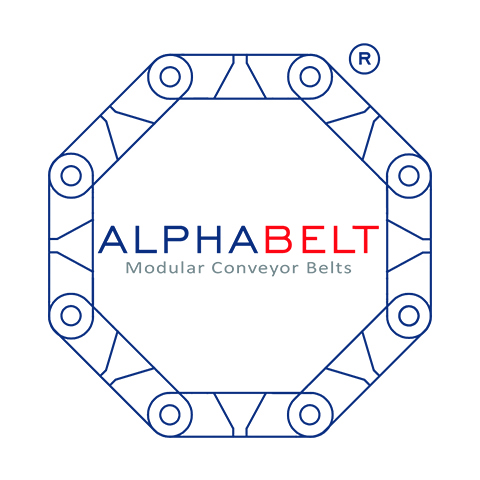
PDF FILE: SPROCKET QUANTITY TABLE
Installation-Maintenance Instructions:
During the manufacturing of the conveyors on which you are going to install the Radius belts ALPHAbelt S3125 and S3200, you should pay attention to the following points:
Step1: Conveyor with one curve(drawing 1).
a: When you are going to use a belt S3125 and with width 600mm, the radius in the inner side of the arch must be 2.2 times bigger than the belt's width (R=2,2x belts width.)
When you are going to use a belt S3200 Grid PG with width 390mm, the radius of the turn (R) is 663mm.(R=1,7xbelts width.)
b: In all other cases, the radius of the inner side of the arch must be 2,5 times bigger than the width of the belt (R=2,5xbelts width.)
c: Right before the driveshaft and the idle shaft, there must be straight parts of the belt, equal to 1.5x its width.
Step 2: Conveyor with two or more opposite curves (drawing 2):
a: Apply the above-mentioned points a,b,c.
b: Between two opposite directions of the belt, there must be a middle straight part of the belt, with length equal to the double of the width of the belt.
Step 3:Side Guides (SG).
a. In the points that the belt contacts the metallic construction, there is the need to put Side Guides (SG), which will be made of a material resistant enough to the temperature that the belt is going to function and in the friction it is going to be submitted.
The accuracy in the construction and the installation of the SG defines the proper function and the life duration of the belt.
b.The SG should be made of a material with low friction factor, order to be damaged and damage the belt the less the possible.
c.The SG is a «sacrificial» component. For this reason, they should be installed in such a way that they're replaced to be made easily and quickly.
d. Only for type S3200 Grid PG. In the case that the belt in its return must follow the same direction with the product conveyance surface, you should put SG also in the return side of the belt (drawing 3).
Step 4:Drive Sprockets and Idle Sprockets:
a. The Drive Sprockets and the Idle Sprockets are similar. They are installed on square shaft 40 Χ 40 mm.
b.The installation of the sprockets on the driveshaft and the idle shaft must be made according to the drawing 3 & 6
c. The middle sprockets on each shaft must be locked on the shaft (drawing 7). The rest sprockets on each shaft must be unlocked, to be able to follow the belt in case of expansion or contraction.
d. The teeth of the sprockets must be in the same straight line (drawing 8).
e.The teeth of the sprockets must work with the belt in the point that is shown in drawing 9.
Step 5:Installation and start of the belt:
a. Each belt is received in one or more roles.
To connect two roles use the connecting rod that comes with each role
During the connection of the roles, pay attention to the points that the belt works with the sprockets, to be on the same side.
Put the belt on the metallic construction, but the teeth of the sprockets in the right insertions of the belt (drawing 9) and connect the two edges of the belt with the plastic connection rod.
After the connection of the belt, use a thermal device and heat the two-edged of the connection rod and, right after that, push with a metallic object until their diameter becomes at least 2 mm. bigger and do not exceed from the belt.
b.Give motion to the conveyor belt. Notice for a whole turn of the belt, that the teeth of the sprockets on the driveshaft and the idle shaft are in the right position. If you notice any «sliding» of the sprockets repeat the steps 4 & 5.
c.If you hear any sound from the belt in the points that contact the sprockets repeat the steps 4&5.
MAINTENANCE:
The yearly check of the connection rod is necessary.
If you notice that the diameter of the connecting rod has been reduced by 15%, it must be replaced, because it will cause problems in the belt and sprockets.
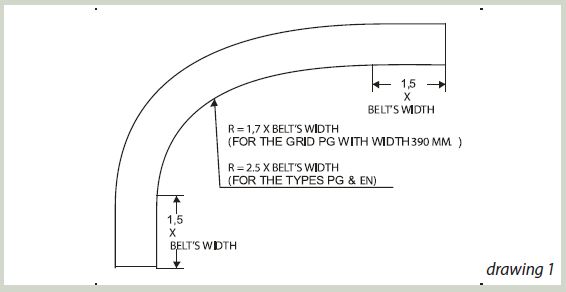
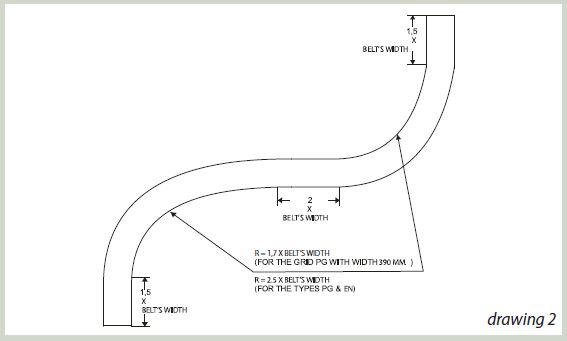
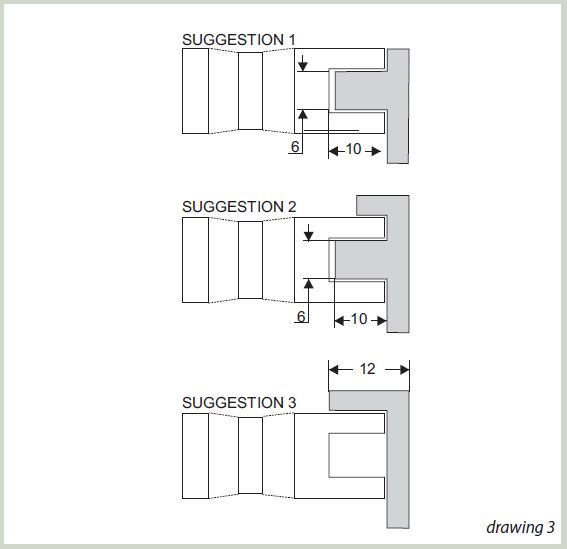



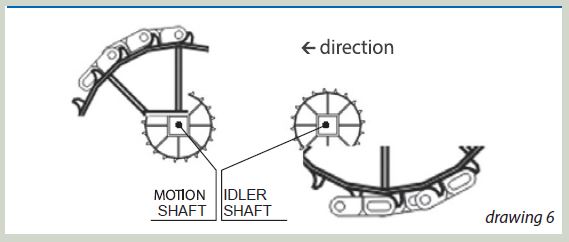


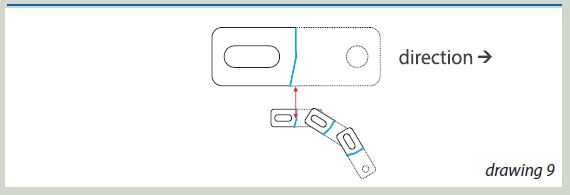
Material specifications
POLYETHYLENE (PE) Thermal plastic with specific gravity approximately 0,92 gr.\cm3.Suitable for use in a cold environment.Temperature range from –73 up to +66 Celcius degrees. High chemical resistance.FDA approved. Stiff but also flexible material with high impact strength
POLYPROPYLENE (PP) Thermal plastic with specific gravity approximately 0,92 gr.\cm3.Suitable for use in higher temperatures.Temperature range from +5 up to +100 Celcius degrees. High chemical resistance.FDA approved. Stiff material with medium intense strength and low impact strength in low temperatures.
PTV Thermal plastic with specific gravity approximately 1.15 gr.\cm3,(self-immersed in water).Suitable for use in high temperatures.Temperature range from +40 up to +130 Celcius degrees Low chemical resistance. Stiff material with medium intense strength and low impact strength in low temperatures.
PGT Thermal plastic with specific gravity approximately 1.16 gr.\cm3,(self-immersed in water).Suitable for use in high temperatures.Temperature range from +50 up to +150 Celcius degrees.Great chemical resistance.
Strong and stiff material. Excellent impact strength, but with high friction between supports and belt.Low impact strength in low temperatures.
POLYPROPYLENE GLASS-FORCED(PPGF) Thermal plastic with specific gravity approximately 1,14 gr.\cm3. Suitable for use in high temperatures.Temperature range from +50 up to +150 Celcius degrees.Great chemical resistance.Strong and stiff material. Excellent impact strength, but with high friction between support and belt.Low impact strength in low temperatures.
POLYPROPYLENE ANTISTATIC (PPAN) Thermal plastic with specific gravity approximately 0,98 gr.\cm3.Suitable for use where static build-up must be dissipated. Temperature range from +5 up to +100 Celcius degrees. Great chemical resistance. The impact strength matches this of plain polypropylene.
POLYPROPYLENE FLAME RETARDANT (PPAF)Thermal plastic with specific gravity approximately 0,98 gr.\cm3.Suitable for use in an environment with high temperature, as microwave ovens etc. Temperature range from +5 up to +120 Celcius degrees.High chemical resistance. Flame resistant VO (3,2 mm.) FDA approved. Stiff material with medium endurance and low impact strength in low temperatures.
ACETAL (AC) Thermal plastic with specific gravity approximately 1,4 gr.\cm3.Suitable for use in high and low temperature.Temperature range from -43 up to +95 Celcius degrees.Low resistance in certain chemicals. FDA approved. Consistent stiff material with high-intensity strength.Low friction between the belt and support.Low impact strength in low temperatures.
ACETAL ANTISTATIC (ACAN) Thermal plastic with specific gravity approximately 1,4 gr.\cm3.Suitable for use where static build-up must be dissipated. Temperature range from -43 up to +95 Celcius degrees. Low resistance in certain chemicals.FDA approved. Consistent stiff material with high-intensity strength.Low friction between the belt and support.Low impact strength in low temperatures.
NYLON 6 (PA6) Thermal plastic with specific gravity approximately 1,08 gr.\cm3.Suitable for use in high and low temperature.Temperature range from -45 up to +110 Celcius degrees. High chemical resistance.Is not suitable for use in an environment with humidity in high temperature.FDA approved. Strong but flexible material, with excellent intense and impart strength.
NYLON 6 GLASS-FORCED (PAGF) Thermal plastic with specific gravity approximately 1,22 gr.\cm3. Suitable for use in high and low temperature.Temperature range from -30 up to +110 Celcius degrees. High chemical resistance.Is not suitable for use in an environment with humidity in high temperature. Strong and unchangeable material, with excellent intense and impact strength.
Chemical Specifications
Material's Resistance In Chemicals:
The values in the following charts are indicative. Factors like the materials filling, temperature, concentration and elasticity can alter the following values significantly. Thus, no guarantee can be given for the correctness of the mentioned values. These values are valid in temperature 20Celsius degrees.
Symbols Explanation:
+Resistance No change or very slight change in weight (<0.5%). No change in mechanical characteristics.
+/-Duration in time After some time significant changes in weight, mass,(0.5-5) Possible strength and flexibility reduce. Extensive use only in simple uses of materials.
- Unsuitable Significant and fast denaturation in weight, mass(>5%), significant denaturation in strength and flexibility. Not advisable to use.
%Consentration If value is given is because no test resalt from materials suppliers is available.
Calculate Correctly:
All the objects (plastic or metallic) change their dimensions, according to the environment temperature fin which they function.
To calculate the dimensions of a belt and the metallic construction of a conveyor, the following should be calculated.
.
Calculation example of the expansion of a conveyor belt, made of Polypropelene, with dimensions 10m (10.000mm) lengthand 1,1m (1.100mm) width, which functions in an environment with temperature +90C
LENGTH
E= 10 χ [(+90)-(+22)] χ 0,12
Ε=81,6mm
WIDTH
E= 1,1 χ [(+90)-(+22)] χ 0,12
Ε=9mm
Calculation example of the contraction of a conveyor belt, made of Polyethelene, with dimensions 10m (10.000mm) length and 1,1m (1.100mm) width, which functions in an environment with temperature -60C.
LENGTH
C= 10 χ [(-60) - (+22)] χ 0,12
C=98,4mm
WIDTH
C=1,1 χ [(-60) - (+22)] χ 0,12
C=11mm
PDF FILE: Inquiry Form




